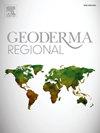利用遥感和地形协变量提高缅甸中部旱区数字土壤制图的精度
IF 3.3
2区 农林科学
Q2 SOIL SCIENCE
引用次数: 0
摘要
遥感在数字土壤制图中得到广泛应用,为土地资源管理和环境监测提供支持。然而,在潮湿的热带地区,光学传感器的有效性经常受到持续云层覆盖的限制。因此,这些领域的许多研究主要依赖地形变量作为协变量。本研究旨在通过结合遥感图像和地形变量,在缅甸中部干旱区Pyawbwe镇实现高精度制图,覆盖面积为1,650平方公里。本研究探讨了(1)土壤性质与Landsat 5波段月度复合影像遥感预测因子对土壤性质预测精度的相关性;(2)地形变量与Landsat 5影像结合后,数字土壤制图预测精度的提高。相关分析和回归分析表明,光谱波段与土壤性质之间存在显著的相关性。将Landsat图像与地形数据相结合,不断提高了使用随机森林(RF)和立体模型对土壤性质的预测,在某些情况下,与单独使用地形的模型相比,R2值增加了一倍以上。特别是粘土含量(RF的R2从0.27提高到0.54,立体派的R2从0.14提高到0.57)、有效阳离子交换容量(RF的R2从0.17提高到0.48,立体派的R2从0.07提高到0.42)和沙子含量(RF的R2从0.15提高到0.46,立体派的R2从0.10提高到0.50)。线性相关分析结果表明,3月、5月和12月休耕期黏土、粉土、砂土、有效阳离子交换量和交换性镁在近红外和短波红外波段的相关性最高。这些结果表明,在这些时期,利用遥感来解释土壤肥力、质地和养分供应能力是有潜力的。本文章由计算机程序翻译,如有差异,请以英文原文为准。
Improving the accuracy of digital soil mapping using remote sensing and topography covariates in the Central Dry Zone of Myanmar
Remote sensing has been extensively applied in Digital Soil Mapping to support land resource management and environmental monitoring. However, in humid tropical regions, the effectiveness of optical sensors is often constrained by persistent cloud cover. As a result, many studies in these areas rely primarily on topographic variables as covariates. This study aims to achieve high-accuracy mapping by combining remote sensing images and topographic variables in the Pyawbwe township of the Central Dry Zone of Myanmar, covering 1,650 km2. This study explored (1) the correlation between soil properties and remote sensing predictors retrieved from monthly composite images of Landsat 5 bands on the accuracy of soil property predictions and (2) the improved prediction accuracy of Digital Soil Mapping when topographic variables were combined with Landsat 5 images. Correlation and regression analyses show significant relationships between spectral bands and soil properties. Integrating Landsat imagery with topographic data consistently improved the prediction of soil properties using Random Forest (RF) and Cubist models, with R2 values more than double in some cases compared to models using topography alone. Particularly for clay content (R2 improved from 0.27 to 0.54 for RF and 0.14 to 0.57 for Cubist), effective cation exchange capacity (from 0.17 to 0.48 for RF and 0.07 to 0.42 for Cubist), and sand content (from 0.15 to 0.46 for RF and 0.10 to 0.50 for Cubist). Results from linear correlation analysis show that clay, silt, sand, effective cation exchange capacity, and exchangeable magnesium display the highest correlations with near-infrared and shortwave infrared bands during the fallow period in March, May, and December. The results suggest the potential for using remote sensing to interpret soil fertility, texture, and nutrient-supplying capacity during these periods.
求助全文
通过发布文献求助,成功后即可免费获取论文全文。
去求助
来源期刊

Geoderma Regional
Agricultural and Biological Sciences-Soil Science
CiteScore
6.10
自引率
7.30%
发文量
122
审稿时长
76 days
期刊介绍:
Global issues require studies and solutions on national and regional levels. Geoderma Regional focuses on studies that increase understanding and advance our scientific knowledge of soils in all regions of the world. The journal embraces every aspect of soil science and welcomes reviews of regional progress.
 求助内容:
求助内容: 应助结果提醒方式:
应助结果提醒方式:


